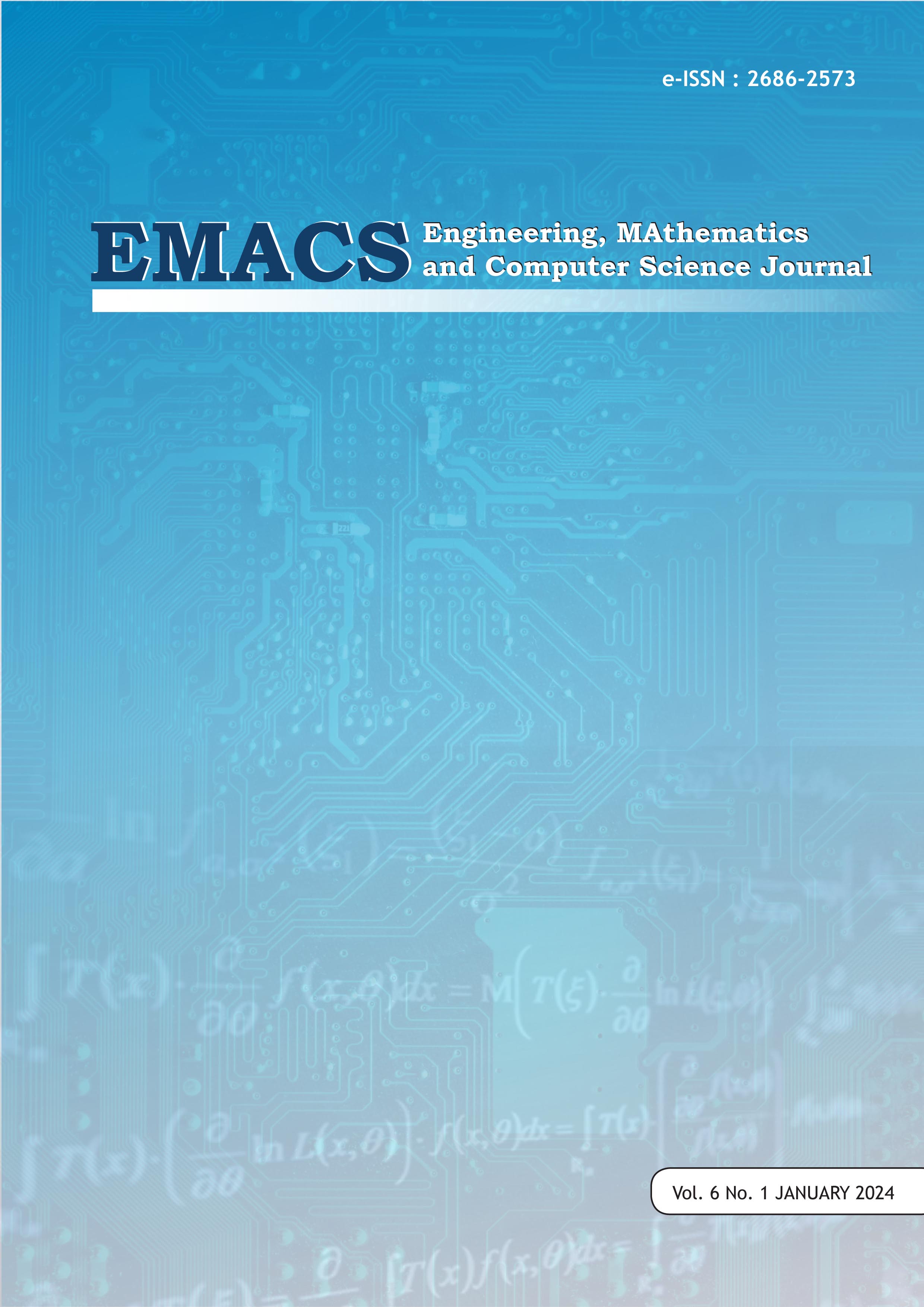Calorie Tracking: A Mobile Application for Tracking Eating Patterns and Intake
DOI:
https://doi.org/10.21512/emacsjournal.v6i1.11193Keywords:
Eating Scheme, Calorie Intake, Human and Computer Interaction, PrototypeAbstract
A balanced regular calorie intake along with a good eating rules is an important factor to fullfill a healthy lifestyle and diet. Both are the main keys to preventing non-communicable diseases (NCDs) which are the largest contributors to world deaths. The effects produced through dietary regulation and calorie intake ideally will affect to the long term, so that consistency and adequate supporting media are needed. Judging from the time scale, action is needed since in, Early action is needed, especially for students who are in the transition period to maturity and independence. Technological developments in the digital era can be used to produce problem solutions ranging from fundamental aspects. Students themselves are familiar with the concept of the calorie tracker application (Craker) even though the majority have never used it. The purpose of this paper is to design the Craker application as a form of solution to regulate diet and calorie intake by applying the theory of human and computer interaction. The result of making this application is to monitor the number of calories consumed by knowing the number of calories in and out so that it is balanced according to the recommendations given based on the user’s profile, for the calorie tracker application we can divide it into three types of calorie tracker applications: web, mobile, and physical.
References
Baequny, A., Harnany, A. S., & Rumimper, E. (2015). Pengaruh Pola Makan Tinggi Kalori terhadap Peningkatan Kadar Gula Darah pada Penderita Diabetes Mellitus Tipe 2. Jurnal Riset Kesehatan, 4(1), 687–692.
Boyle, M. A., & Long, S. R. (2010). Personal Nutrition USA. Wadworth Printed Access Code.
Budreviciute, A., Damiati, S., Sabir, D. K., Onder, K., Schuller-Goetzburg, P., Plakys, G., Katileviciute, A., Khoja, S., & Kodzius, R. (2020). Management and prevention strategies for non-communicable diseases (NCDs) and their risk factors. Frontiers in Public Health, 8, 788.
Dennis, A., Wixom, B., & Tegarden, D. (2015). Systems analysis and design: An object-oriented approach with UML. John wiley & sons.
Gadient, P., Ghafari, M., Tarnutzer, M.-A., & Nierstrasz, O. (2020). Web apis in android through the lens of security. 2020 IEEE 27th International Conference on Software Analysis, Evolution and Reengineering (SANER), 13–22.
Graham, D., Veenendaal, E. van, Evans, I., & Black, R. (2008). Foundations of software testing: ISTQB certification. Intl Thomson Business Pr.
Hunt, J., & McManus, A. G. (2013). Key Java: advanced tips and techniques. Springer Science & Business Media.
Jia, J., & Le, H. (2020). The design and implementation of a computerized adaptive testing system for school mathematics based on item response theory. Technology in Education. Innovations for Online Teaching and Learning: 5th International Conference, ICTE 2020, Macau, China, August 19-22, 2020, Revised Selected Papers 5, 100–111.
Koç, H., Erdoğan, A. M., Barjakly, Y., & Peker, S. (2021). UML diagrams in software engineering research: a systematic literature review. Proceedings, 74(1), 13.
Kumar, N., Lopez, C., Caldeira, C. M., Pethe, S., Si, B., & Kobsa, A. (2016). CalNag: effortless multiuser calorie tracking. 2016 IEEE International Conference on Pervasive Computing and Communication Workshops (PerCom Workshops), 1–4.
Kurniawati, Y., Fakhriadi, R., & Yulidasari, F. (2016). Hubungan antara pola makan, asupan energi, aktivitas fisik, dan durasi tidur dengan kejadian obesitas pada polisi. Jurnal Publikasi Kesehatan Masyarakat Indonesia, 3(3).
Mos, A., & Chowdhury, M. M. (2020). Mobile security: A look into android. 2020 IEEE International Conference on Electro Information Technology (EIT), 638–642.
Munthe, I. R., Rambe, B. H., Pane, R., Irmayani, D., & Nasution, M. (2020). UML Modeling and Black Box Testing Methods in the School Payment Information System. Jurnal Mantik, 4(3), 1634–1640.
Pressman, R. S. (2005). Software engineering: a practitioner’s approach. Palgrave macmillan.
Rani, M., Ardiansyah, R., Kurniawan, M. A., & Christy, T. (2022). APPLICATION OF EXPERT SYSTEM (FORWARD CHAINING METHOD) IN DIAGNOSIS OF PRINTER FAILURE. JOURNAL OF DYNAMICS (International Journal of Dynamics in Engineering and Sciences), 17(2), 172–177.
Senarath, U. S. (2021). Waterfall methodology, prototyping and agile development. Tech. Rep., 1–16.
Downloads
Published
How to Cite
Issue
Section
License
Copyright (c) 2024 Nyoman Ayu Gita Gayatri, Juan Xavier Soegiarto, Philips Sanjaya, Vincent Tanujaya, Nicholas Diporedjo, Aaron Medhavi Kusnandar, Justin Tjokro, Yulyanty Chandra

This work is licensed under a Creative Commons Attribution-ShareAlike 4.0 International License.
Authors who publish with this journal agree to the following terms:
- Authors retain copyright and grant the journal right of first publication with the work simultaneously licensed under a Creative Commons Attribution License - Share Alike that allows others to share the work with an acknowledgment of the work's authorship and initial publication in this journal.
- Authors are able to enter into separate, additional contractual arrangements for the non-exclusive distribution of the journal's published version of the work (e.g., post it to an institutional repository or publish it in a book), with an acknowledgment of its initial publication in this journal.
- Authors are permitted and encouraged to post their work online (e.g., in institutional repositories or on their website) prior to and during the submission process, as it can lead to productive exchanges, as well as earlier and greater citation of published work.
USER RIGHTS
All articles published Open Access will be immediately and permanently free for everyone to read and download. We are continuously working with our author communities to select the best choice of license options, currently being defined for this journal as follows: Creative Commons Attribution-Share Alike (CC BY-SA)





